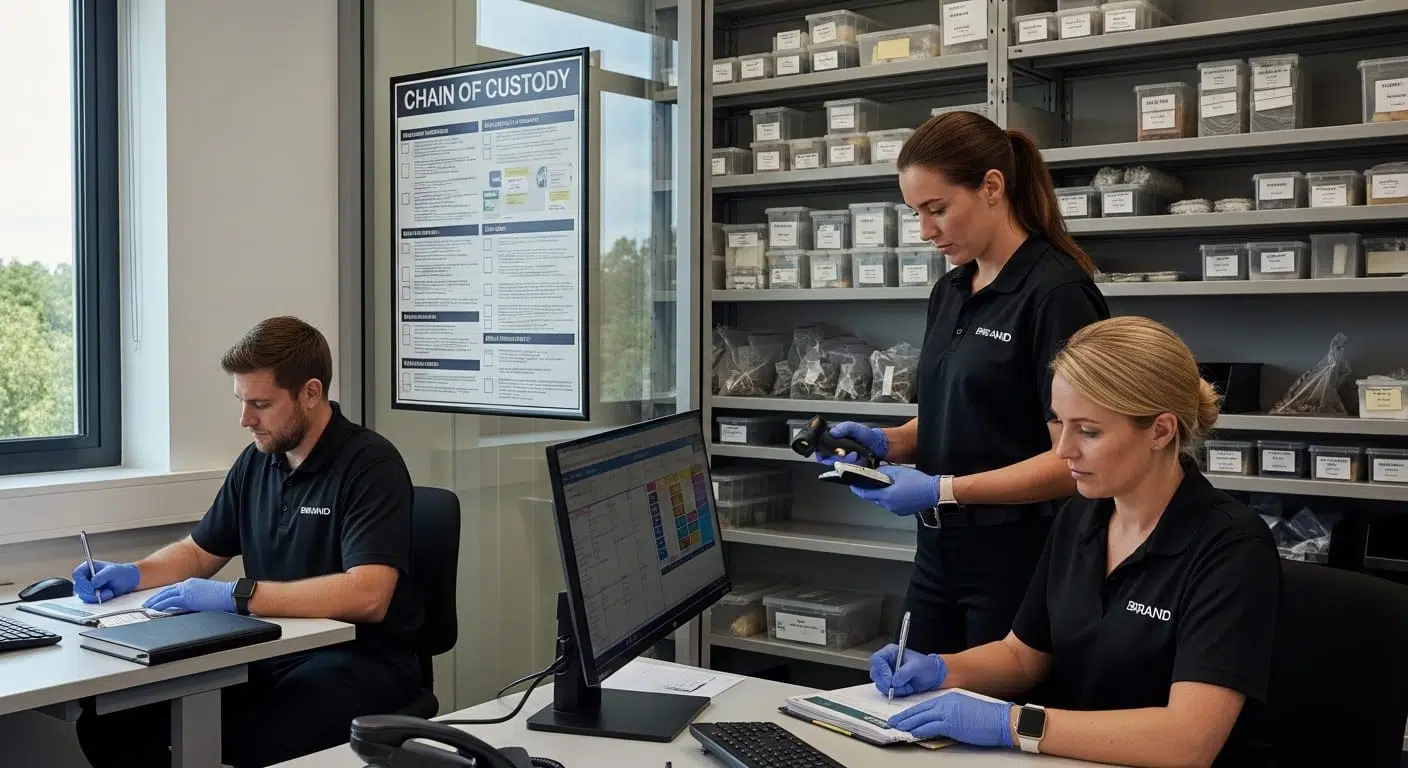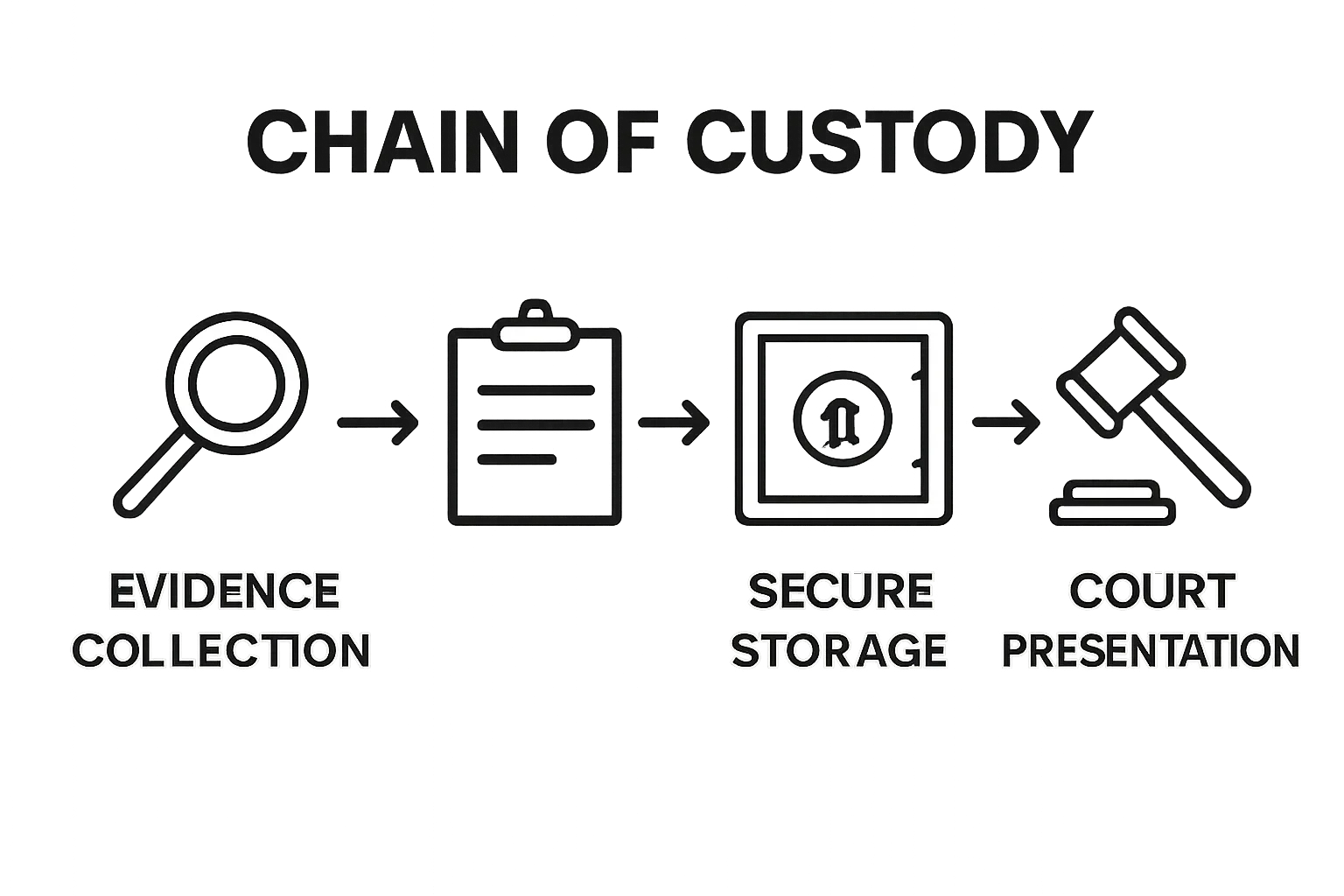Every piece of evidence in a legal case must pass through countless hands before it ever reaches the courtroom. Here is the surprising part. Even a tiny mistake in the record-keeping process can get crucial evidence thrown out, and nearly 40 percent of cases involving forensic evidence have faced challenges due to chain of custody issues. That simple paper trail can change the entire course of justice.
Table of Contents
- What Is Chain Of Custody And Its Importance?
- The Key Elements Of Chain Of Custody Procedures
- How Chain Of Custody Maintains Evidence Integrity
- Real-World Applications And Challenges Of Chain Of Custody
- The Role Of Chain Of Custody In Legal Outcomes
Quick Summary
| Takeaway | Explanation |
|---|---|
| Maintain precise documentation of evidence | Accurate records are essential for tracking evidence from collection to court, ensuring integrity and admissibility. |
| Implement robust tracking and transfer mechanisms | Each transfer of evidence must be logged to establish accountability and prevent contamination, enhancing reliability in legal contexts. |
| Follow strict preservation and storage standards | Use appropriate storage conditions to protect evidence, particularly digital, from potential degradation and tampering during investigations. |
| Foster accountability among evidence handlers | Document every individual involved in handling evidence to create a transparent record, mitigating risks of evidence manipulation or incompetence. |
| Embrace technological solutions for evidence validation | Modern tools like cryptographic hashing enhance verification processes, ensuring the integrity of electronic evidence throughout its lifecycle. |
What is Chain of Custody and Its Importance?
Chain of custody procedures represent a critical legal mechanism for documenting and tracking evidence through its entire lifecycle, ensuring its integrity, authenticity, and admissibility in legal proceedings. This systematic approach provides a comprehensive record of every interaction, transfer, and handling of physical or digital evidence from its initial collection to its presentation in court.
Defining Chain of Custody
A chain of custody is a meticulous documentation process that tracks the movement, location, and handling of evidence. It creates a chronological paper trail that details who collected the evidence, when it was collected, how it was stored, and who had access to it at each stage. This process is fundamental in legal and forensic investigations, particularly in criminal cases where the reliability of evidence can determine the outcome of a trial.
Key Components and Significance
The chain of custody serves multiple critical purposes in legal and investigative contexts:
- Preservation of Evidence Integrity: Ensures that evidence remains uncontaminated and unchanged from its original state
- Legal Admissibility: Provides a transparent record that demonstrates evidence has not been tampered with or compromised
- Accountability: Creates a clear audit trail of all individuals who handled the evidence
According to the National Criminal Justice Reference Service, maintaining a rigorous chain of custody is essential for establishing the credibility and authenticity of evidence in court. Any gaps or inconsistencies in the documentation can potentially lead to evidence being deemed inadmissible, which could significantly impact the outcome of a legal case.
In digital forensics, chain of custody procedures are particularly complex. Digital evidence can be fragile and easily altered, making precise documentation even more crucial. Forensic experts must follow strict protocols to capture, preserve, and transfer digital evidence without compromising its original state or metadata.
Professionals involved in chain of custody must meticulously record every detail, including the precise time of collection, identification of the evidence, conditions of storage, and a comprehensive log of all individuals who accessed the evidence. This documentation typically involves detailed forms, photographic evidence, sealed evidence bags, and secure storage protocols.
The Key Elements of Chain of Custody Procedures
Chain of custody procedures require a systematic and comprehensive approach to managing evidence, with several critical elements that ensure its legal reliability and forensic integrity. Understanding these key components is essential for professionals working in legal, investigative, and forensic disciplines.
Documentation and Recording Protocols
Documentation forms the cornerstone of effective chain of custody procedures. Every piece of evidence must be meticulously recorded with precise details that create an unambiguous trail of its journey. Comprehensive documentation typically includes specific information such as the exact time and date of collection, the precise location, the identity of the collecting officer, and initial observations about the evidence.
Tracking and Transfer Mechanisms
Effective chain of custody relies on robust tracking mechanisms that document each transfer and interaction with the evidence. This involves creating a systematic log that records:
- Who handled the evidence
- When the evidence was transferred
- The purpose of each transfer
- The condition of the evidence at each stage
These transfer protocols ensure transparency and accountability throughout the evidence lifecycle. Each transfer requires a formal handover process, with both parties acknowledging the transfer through signed documentation.
Research from the US Department of Justice highlights that rigorous tracking procedures are fundamental in preventing potential evidence contamination or manipulation. The tracking process must be so precise that any external party could reconstruct the evidence’s entire journey from collection to presentation.
Preservation and Storage Standards
Preservation standards are crucial in maintaining evidence integrity. Different types of evidence require specific storage conditions to prevent degradation or contamination. Digital forensics, for instance, demands specialized storage protocols that protect electronic data from magnetic interference, temperature variations, and potential unauthorized access.
Forensic experts must implement secure storage solutions that include:
- Sealed and tamper-evident evidence containers
- Climate-controlled storage environments
- Access-restricted storage facilities
- Detailed inventory management systems
These comprehensive preservation strategies ensure that evidence remains in its original condition, maintaining its legal and scientific validity throughout the investigative and legal processes.
The table below summarises the key elements of effective chain of custody procedures, providing a quick reference for professionals on the essential components to ensure evidence reliability.
| Element | Description |
|---|---|
| Documentation and Recording | Accurate records detailing collection time, date, location, handler identity, and observations |
| Tracking and Transfer | Systematic logging of every evidence transfer, including purpose and condition at each stage |
| Preservation and Storage | Use of secure, tamper-evident containers and climate-controlled, access-restricted facilities |
| Accountability | Transparent identification and logging of every individual who handles evidence |
| Technological Verification | Utilisation of tools such as cryptographic hashing and metadata preservation |
How Chain of Custody Maintains Evidence Integrity
Maintaining evidence integrity is a complex process that requires meticulous attention to detail and strict procedural protocols. Chain of custody procedures serve as a critical safeguard against potential evidence manipulation, contamination, or tampering, ensuring that legal and forensic evidence remains credible and admissible throughout investigative processes.
Preventing Evidence Contamination
Evidence contamination can occur through various means, potentially rendering critical forensic information unreliable. Strict handling protocols are designed to minimise the risk of physical or digital evidence being compromised. These protocols involve implementing protective measures such as wearing sterile gloves, using specialized collection tools, and maintaining controlled environments during evidence handling and storage.
Establishing Forensic Accountability
Accountability is a fundamental principle in maintaining evidence integrity. Each individual who handles evidence must be precisely documented, creating a transparent and traceable record of interactions. This accountability mechanism includes:
- Detailed personal identification of each handler
- Timestamp of every evidence interaction
- Specific reasons for evidence handling
- Documented condition of evidence before and after handling
Research from the American Academy of Forensic Sciences emphasises that comprehensive accountability reduces the potential for intentional or unintentional evidence manipulation, thus preserving its forensic and legal validity.
Technological and Procedural Verification
Modern chain of custody procedures integrate advanced technological solutions to enhance evidence integrity verification. Digital forensics, in particular, employs sophisticated techniques such as cryptographic hashing and metadata preservation to ensure that electronic evidence remains unaltered.
These technological approaches complement traditional procedural methods by providing additional layers of verification. Forensic experts use specialized software and hardware tools to create immutable digital fingerprints of electronic evidence, allowing instant detection of any subsequent modifications.
By combining rigorous documentation, strict accountability, and advanced technological verification, chain of custody procedures create a robust framework that protects the fundamental integrity of forensic evidence.

Real-World Applications and Challenges of Chain of Custody
Chain of custody procedures extend far beyond theoretical frameworks, presenting complex practical challenges across multiple professional domains. These procedures are critical in ensuring evidential reliability and maintaining legal and forensic standards in diverse investigative contexts.
Diverse Professional Applications
Chain of custody procedures are implemented across numerous professional fields, each with unique requirements and complexities. Legal investigations, digital forensics, medical research, and law enforcement represent critical areas where meticulous evidence tracking becomes paramount. These domains require sophisticated mechanisms to document, preserve, and validate evidence through comprehensive tracking systems.
Sector-Specific Challenges
Different professional sectors encounter distinctive challenges in implementing chain of custody protocols:
- Digital Forensics: Managing rapidly changing technological landscapes
- Criminal Investigations: Maintaining evidence integrity across multiple jurisdictions
- Corporate Investigations: Protecting sensitive information during evidence collection
- Medical Research: Ensuring biological sample traceability and compliance
Research from the International Association for Property and Evidence demonstrates that successful chain of custody implementation requires adaptive strategies tailored to specific institutional contexts.
Technological and Human Factor Complexities
Implementing robust chain of custody procedures involves navigating intricate technological and human challenges. Technological vulnerabilities such as data corruption, hardware failures, and cybersecurity risks can compromise evidence integrity. Simultaneously, human error represents a significant potential point of failure, with individual lapses in documentation or handling potentially invalidating critical evidence.
Forensic professionals must develop comprehensive training programmes that address both technological proficiency and meticulous procedural adherence. This involves creating systematic approaches that minimise human error while leveraging advanced technological solutions for evidence tracking and verification.
By understanding and addressing these multifaceted challenges, organisations can develop more resilient and reliable chain of custody protocols that withstand rigorous legal and scientific scrutiny. The ongoing evolution of technological capabilities and investigative methodologies continues to reshape these critical procedural frameworks.
The following table compares key sector-specific challenges faced when maintaining chain of custody across various professional domains, highlighting the unique considerations each field must address.
| Sector | Unique Challenge |
|---|---|
| Digital Forensics | Managing rapidly evolving technology and protecting electronic data |
| Criminal Investigations | Maintaining evidence integrity across multiple jurisdictions |
| Corporate Investigations | Protecting sensitive information during evidence collection |
| Medical Research | Ensuring biological sample traceability and regulatory compliance |
The Role of Chain of Custody in Legal Outcomes
Chain of custody procedures represent a critical mechanism that directly influences legal proceedings, potentially determining the success or failure of criminal and civil cases. The precise documentation and tracking of evidence can be the decisive factor in judicial decisions, making these procedures fundamental to the administration of justice.
Evidence Admissibility and Judicial Scrutiny
Legal admissibility hinges on the comprehensive and transparent documentation of evidence throughout its lifecycle. Courts apply stringent standards when evaluating the reliability and integrity of submitted evidence. Judicial scrutiny focuses on whether the evidence has been collected, stored, and transferred in a manner that prevents potential contamination or manipulation.
Critical Legal Implications
The implications of chain of custody extend beyond mere procedural requirements. Potential consequences of inadequate evidence management include:
- Complete exclusion of critical evidence
- Undermining of prosecution arguments
- Potential case dismissal
- Challenges to investigative credibility
Research from ResearchGate demonstrates the direct correlation between meticulous chain of custody procedures and successful legal outcomes, highlighting the profound impact of systematic evidence management.
Burden of Proof and Evidentiary Standards
Legal professionals must meet exceptionally high evidentiary standards to ensure that evidence remains admissible. This requires creating an unbroken, transparent record that demonstrates the evidence has not been altered or compromised. Digital and physical evidence must undergo rigorous verification processes that validate its origin, integrity, and continuous preservation.
Forensic experts and legal professionals must collaborate to develop comprehensive documentation that withstands intense judicial examination. This involves creating detailed logs, maintaining secure storage protocols, and implementing technological verification mechanisms that provide irrefutable proof of evidence authenticity.
Ultimately, chain of custody procedures serve as a critical safeguard in the legal system, ensuring that justice is served through reliable, uncontaminated, and meticulously documented evidence. The precision and thoroughness of these procedures can mean the difference between a successful prosecution and a case that collapses under judicial scrutiny.
Protect Your Case With Flawless Chain of Custody Procedures
Maintaining the integrity and credibility of digital evidence can be overwhelming, especially when every step is scrutinised in court. If you are concerned about evidence documentation, unbroken audit trails, or the real risk of evidence being deemed inadmissible, you are not alone. The complexities described in our article on chain of custody can leave even experienced professionals at risk of human error or procedural gaps. Our team at Digital Forensic Investigation can help you overcome these challenges with industry-leading expertise.
Do not leave the outcome of your investigation to chance. Partner with Computer Forensics Lab for secure evidence collection, proper documentation and expert witness support that stands up in court. Learn more about our proven methods and see our knowledge applied in real-world scenarios by visiting our Infographics section. Take control of your evidence chain today by contacting us for tailored digital forensic solutions that protect your case from start to finish.
Frequently Asked Questions
What is chain of custody in legal terms?
Chain of custody is a procedural method that documents and tracks the handling of evidence from collection through storage and presentation in court. It ensures the integrity and admissibility of the evidence.
Why is maintaining chain of custody important?
Maintaining the chain of custody is crucial for preserving evidence integrity, ensuring its legal admissibility, and creating accountability among those involved in handling the evidence.
What are the key components of chain of custody procedures?
Key components include meticulous documentation of evidence collection and transfer, strict tracking of who handled the evidence, and established preservation and storage standards to prevent contamination.
How does chain of custody affect legal outcomes?
A well-maintained chain of custody can significantly impact legal outcomes by ensuring that evidence remains reliable and admissible in court, thus influencing the success of prosecutions or defence cases.

